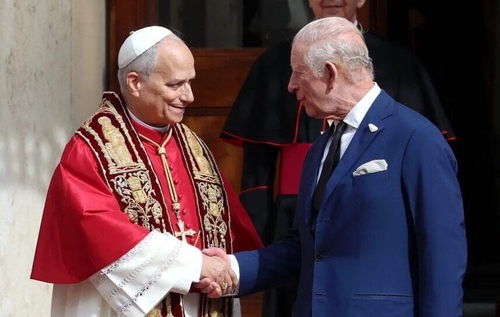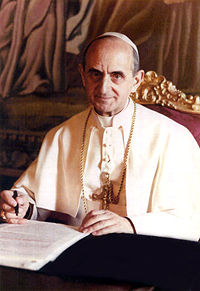
I am appreciating the papacy of Leo XIV as I did that of Pope Francis. The prayerful visit of King Charles to the Vatican was a marvellous moment in these early days. Others are less sanguine about this historic event. In particular, people point to Ian Paul’s Psephizo article as underscoring
three major issues where the Church of England and the Church of Rome have fundamental disagreements, and, despite the establishment of improved personal relations, these differences do not appear to have changed.
I want to highlight that there are different ways to view ecumenical relationships, different lenses through which they can be seen. And these different perspectives shape how “major” one regards these three particular “issues”.
Let me outline some history of ecumenism.
The mid-20th century ecumenical movement (especially after Vatican II and the Anglican–Roman Catholic International Commission, ARCIC) aimed for doctrinal convergence leading to visible unity. There has, more recently, been a shift to “Receptive Ecumenism” which does not seek what can be conceded but, rather, what can we learn or receive from the other tradition’s strengths in order to grow more faithfully into the truth of Christ?
From this Receptive Ecumenism approach there has been a growing stress on doing together whatever we can do together. This has meant Christians of different traditions working together on ecological issues, climate change, justice and peace, and so forth. It has been noted that in Pope Leo’s completion of the Apostolic Exhortation started by Pope Francis, Dilexi Te, Scripture has been placed front and centre – rather than the common Vatican focus on papal teachings and reason [the latter generally seeks to attract engagement with all people of good will, whereas the biblical focus immediately resonates with all who share the Scriptures].
Within this context of stressing doing together whatever we can do together (rather than waiting to tick every box of doctrinal agreement) there are shared liturgical celebrations. The Vatican explicitly includes “the rite of washing the feet, the imposition of ashes on Ash Wednesday and celebrating prayer vigils and liturgies of the Word for major feasts such as Christmas, Epiphany, the Ascension, Pentecost and the feast of Sts. Peter and Paul.”
So, I would place the King and Pope praying together within this 21st Century move from the realm of theological documents to that of shared practices and gestures of reception. Furthermore, joint prayer IS a theological statement: that communion is already partial yet real. It moves from the rational-propositional mode of earlier dialogues into developing genuine friendships as a theological mode.
My formal relationship as an Anglican priest to a Roman Catholic Cistercian monastery is a good example of this newer dynamic of ecumenism. And I spoke about this at the international conference in Avila of people associated formally with Cistercian monasteries.
Let me also stress at this point that Anglicanism views itself as a reformed/renewed form of catholicism. And this is also the (still-growing) reality of Roman Catholicism after Vatican II – with vernacular liturgy, an emphasis on the Scriptures for all, married clergy, and synodality.
Anglicans and Roman Catholics share the same scripture readings on Sundays and major feast days (and often at daily eucharist). Liturgical rites (from ordinals through Eucharistic services to Confession and ceremonies throughout the year) are extremely similar or even identical.
I’m delighted that I myself am contributing to this doing together whatever we can do together in my work on shared collects, my Book of Prayers in Common. More and more Anglicans and Roman Catholics are praying the same collect, often on the same day. Week by week on this site, I’m providing a commentary on these shared prayers.
Furthermore – in the context of this particular discussion – Anglicanism isn’t a homogenous, single church, it is a family of autonomous provinces. We, for example, in Aotearoa, New Zealand and Polynesia, are in full communion with the Church of England, but our Constitution approaches things a bit differently. Other Anglican churches, similarly, have, as an example within this discussion, a different relationship to the 39 Articles than the Church of England does.
Before proceeding to the “three major issues”, I just want to question one other point that Ian uncritically repeats, that King Charles “being installed as a Confrater of the great basilica of unity St Paul’s outside the Walls [revives this position held by] the English monarchs of the pre-Reformation Church.” I can find no such previous position for English monarchs. Certainly, there are historic ties between the English Crown and the Basilica, there was medieval patronage of the site by Anglo-Saxon rulers. This title, however, is new.
His Majesty has agreed to the suggestion that he become ‘Royal Confrater’ of the Abbey. This gift of ‘confraternity’ is a recognition of spiritual fellowship.
In further celebration of this new bond, the Basilica of St Paul’s Outside the Walls has created a special seat for His Majesty, which will remain in the Basilica as a perpetual mark of mutual respect between Pope Leo and His Majesty as Heads of State. The special chair is decorated with The King’s Coat of Arms [my addition: and the motto “Ut unum sint” (“That they may be one”)]. The King will use this chair during the service, after which it will remain in the apse of the Basilica for future use by His Majesty and his heirs and successors.
Ian Paul’s “three major issues” are
- Eucharistic Presence and the Sacrifice of the Mass
- Ordained ministry
- Authority
The first point in Ian’s blog post contends that there is a substantial difference between Anglican and Roman Catholic understanding of the Eucharist. I would underscore that there is a diversity of theological interpretation within Anglicanism but normally an agreed discipline of practice (that it must be bread and wine that are used, and after consecration it must be consumed or reserved). There is also a diversity of theological interpretation within Roman Catholicism – “transubstantiation” may be a common Roman Catholic shorthand, but many who use that term are not committed to Aristotelian metaphysics of substance and accidents implied by a fundamentalist use of that term.
A binding formulary of the Anglican Church in Aotearoa, New Zealand and Polynesia (the church in which I serve) has:
Praise and glory to you creator Spirit of God;
you make our bread Christ’s body
to heal and reconcile
and to make us the body of Christ.
You make our wine Christ’s living sacrificial blood
to redeem the world.
The above formulary already indicates a variety of (Anglican) interpretations of ‘sacrifice of the Mass’ – part of the first concern. ARCIC’s The Windsor Statement (1971) on “Eucharistic Doctrine” dealt directly with the fear that the Eucharist could be seen as a repetition of Christ’s once-for-all sacrifice or a propitiatory offering by the priest on behalf of the people. Ian’s post plays down the value of ARCIC. Certainly, these documents are not binding on Anglicanism or on Roman Catholicism – that simply misunderstands how ecumenical discussion at the first-stage “doctrinal convergence” worked. [The 1988 Lambeth Conference formally welcomed ARCIC’s Eucharistic agreement as showing “substantial agreement on the doctrine of the Eucharist.”] The document stressed:
The Eucharist is the effectual sign of the sacrifice of Christ … the memorial of the total self-giving of Christ for us, which once offered on the Cross, is made present and real for us in the Eucharist….
The Eucharist is not a repetition of the historical event but the Church’s pleading of Christ’s sacrifice and its making effective here and now by Christ’s own power.Section 5–7
The second point emphasises that in 1896, the encyclical Apostolicae Curae declared Anglican orders “absolutely null and utterly void”. Without exploring the political context in which this encyclical was issued, one has to emphasise that an encyclical is not regarded as infallible within Roman Catholicism. Teachings within Roman Catholicism change (slavery, the death sentence,…) Apostolicae Curae, then, has to be read on its own merit, and alongside the response of the Archbishops of England, Saepius Officio. The US RC Bishops’ document of 2017 is also worth reading.
Many of the criticisms that were levelled at the Anglican ordinal could now be applied to the post-Vatican II ordinal (and the revised RC rite of the Mass). In fact, many conservative Catholics do just that – declaring post-Vatican II RC orders (and Mass) as invalid.
Ecumenical gestures (giving episcopal ring, allowing to preach at Mass…) belie that Anglican orders are null and void. Such actions fit within the shared practice that I emphasised is the new phase we find ourselves in. Furthermore, making ordination “conditional” when moving from Canterbury to Rome is anything but an affirmation of the nineteenth-century “absolutely null and utterly void” understanding of Anglican orders.
Authority is a fraught issue within Christianity, but Ian’s oversimplification of the Anglican and Roman Catholic positions as his third major issue does not do justice to the complexities. Anglicanism cannot be reduced to a “Bible alone” position. In Anglicanism, scripture is read within the life of the Church: in liturgy, under bishops, with creeds, reason, and tradition. Alongside this, let us not under-state the extent to which Roman Catholics also emphasise Scripture. Roman Catholicism is not as simple as “Tradition is equal to Scripture”. Both Anglicanism and Roman Catholicism stand within a contextual, communal reading of Scripture, tradition, and worship.
In an age of polarisation, the meeting and shared prayer of Christian leaders once separated by centuries of conflict should be encouraged and received in the most positive light possible.
Do follow
The Liturgy Facebook Page
The Liturgy Twitter Profile
The Liturgy Instagram
The Liturgy Bluesky Profile
and/or sign up to a not-too-often email


